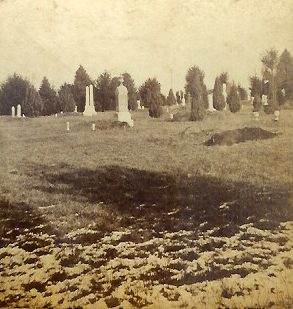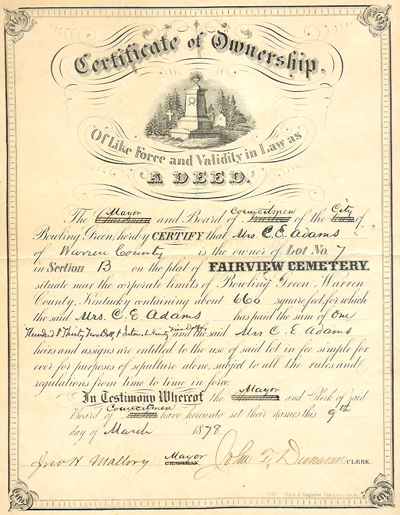As Pioneer Cemetery filled up during the Civil War, the town of Bowling Green began looking for land on which to establish a new public burying ground. One of the sites considered was WKU’s own hill (then known as Copley Knob) but the property, stripped of trees and littered with the debris of war, was deemed unsuitable. (Perhaps the city fathers also took note of what might wash out of and down the hill during a heavy rain?)
Instead, in 1864 the town established Fairview Cemetery on 30 acres of land purchased from one William McNeal. Formally dedicated in 1865, the cemetery has expanded to more than 100 acres and has become the final resting place for many notable citizens, including Mariah Moore (daughter of city founder Robert Moore), WKU’s first president Henry Hardin Cherry, and cake mix magnate Duncan Hines.
The Manuscripts & Folklife Archives section of WKU’s Special Collections Library recently received a donation of an early cash book for Fairview Cemetery. Spanning the years 1871 through 1897, the well-worn book records transactions for lots and supplies, and for the manual labor required to maintain the cemetery — planting flowers, sodding and, of course, digging graves. Alongside regular lot purchases appear payments from the sheriff for “paupers graves” as well as expenses for “reinterring,” reflecting the decision of some families to transfer their loved ones’ remains from Pioneer Cemetery and elsewhere.
Coincidentally, among some stereographic photo cards recently donated to the Special Collections Library are two 1880s images of the cemetery, showing a general view as well as the Confederate Monument, dedicated in 1876. These photos and the cash book recall a time when Fairview Cemetery was only a few decades old, yet well on its way to becoming Bowling Green’s “city of the dead.”
Click here to access a finding aid for the Fairview Cemetery cash book. For other collections relating to cemeteries, search TopSCHOLAR and KenCat.


